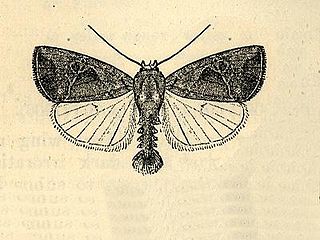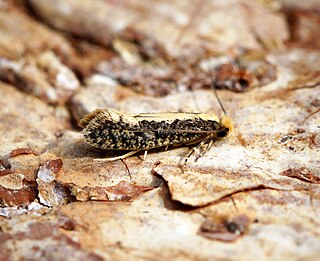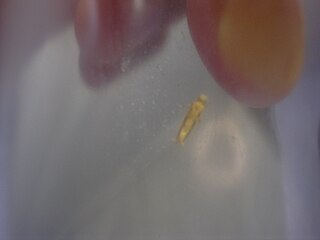
Hawaii is an island state of the United States, in the Pacific Ocean about 2,000 miles (3,200 km) southwest of the U.S. mainland. It is the only state not on the North American mainland, the only state that is an archipelago, and the only state in the tropics.
Located about 2,300 miles (3,680 km) from the nearest continental shore, the Hawaiian Islands are the most isolated group of islands on the planet. The plant and animal life of the Hawaiian archipelago is the result of early, very infrequent colonizations of arriving species and the slow evolution of those species—in isolation from the rest of the world's flora and fauna—over a period of at least 5 million years. As a consequence, Hawai'i is home to a large number of endemic species. The radiation of species described by Charles Darwin in the Galapagos Islands which was critical to the formulation of his theory of evolution is far exceeded in the more isolated Hawaiian Islands.

The Pyralidae, commonly called pyralid moths, snout moths or grass moths, are a family of Lepidoptera in the ditrysian superfamily Pyraloidea. In many classifications, the grass moths (Crambidae) are included in the Pyralidae as a subfamily, making the combined group one of the largest families in the Lepidoptera. The latest review by Eugene G. Munroe and Maria Alma Solis retain the Crambidae as a full family of Pyraloidea.

Laysan is one of the Northwestern Hawaiian Islands, located 808 nautical miles northwest of Honolulu. It has one land mass of 1,016 acres (4.11 km2), about 1 by 1+1⁄2 miles in size. It is an atoll of sorts, although the land completely surrounds Laysan Lake some 2.4 m (7.9 ft) above sea level that has a salinity approximately three times greater than the ocean. Laysan's Hawaiian name, Kauō, means 'egg'.

The Momphidae, or mompha moths, is a family of moths with some 115 described species. It was described by Gottlieb August Wilhelm Herrich-Schäffer in 1857. These moths tend to be rather small with a wingspan of up to 21 mm. The wings are held folded over the body at rest. The larvae are concealed feeders, either as leaf miners or within seeds or stems.

Manduca blackburni, the Hawaiian tomato hornworm, Hawaiian tobacco hornworm or Blackburn's sphinx moth, is a moth in the family Sphingidae.

Thyrocopa is a genus of moths in the family Xyloryctidae endemic to Hawaii. The taxon has approximately forty species, including some flightless species.

Elaphria nucicolora, the sugarcane midget, is a moth of the family Noctuidae. The species was first described by Achille Guenée in 1852. It is found from the south-eastern United States, through Guadeloupe, Jamaica and Puerto Rico to tropical South America. It is also present on the Hawaiian islands of Oahu, Maui and Hawaii.

Spodoptera mauritia, the lawn armyworm or paddy swarming caterpillar, is a moth of the family Noctuidae. The species was first described by Jean Baptiste Boisduval in 1833. Able to eat many types of food, it is a major pest throughout the world.

Hypocala deflorata is a moth of the family Erebidae. It was first described by Johan Christian Fabricius in 1794. It is widespread from India, Sri Lanka to Africa and to Australia and many Pacific islands. Records include China, Borneo, Queensland, Vanuatu, New Caledonia, Rotuma, Fiji, Samoa, Hawaii, Norfolk Island and New Zealand.

Anatrachyntis rileyi, the pink cornworm, pink bud moth or pink scavenger, is a species of moth of the family Cosmopterigidae, the cosmet moths. It was first described by Lord Walsingham in 1882 from the southern United States, but it is probably an introduction to North America. It is found in much of the warm or tropical areas of the world, including northern Australia, the Galápagos Islands, Hawaii, the Antilles, South America and Mauritius.
Praeacedes is a monotypic moth genus in the family Tineidae first described by Hans Georg Amsel in 1954. Its only species, Praeacedes atomosella, was first described by Francis Walker in 1863. It has a wide range and has been recorded from Europe, Australia, Hawaii, India, Malaysia, Solomon Islands, Easter Island, Mauritius, Madagascar, Réunion, South America and North America. The species has commonly been misidentified in various parts of the world.

Monopis crocicapitella, the pale-backed clothes moth, or the bird-nest moth, is a moth of the family Tineidae described by James Brackenridge Clemens in 1859. It has a nearly cosmopolitan distribution. It was first described from the eastern United States.

Erechthias minuscula, the erechthias clothes moth, is a moth of the family Tineidae. It was first described by Lord Walsingham in 1897. It is widespread and has been recorded from Africa, Sri Lanka, Java, Australia, the Caroline Islands, Fiji, Samoa, the Marquesas, the West Indies, Hawaii and Florida.
Dichomeris acuminata, the alfalfa leaf tier, is a moth of the family Gelechiidae. It was first described by Otto Staudinger in 1876. It is a widely distributed species, being known from India, Myanmar, and Sri Lanka southwest to the Seychelles, Mauritius and Réunion and on to Egypt, east and South Africa and southern Europe. Eastward from India it extends through Indonesia and Malaysia to Taiwan and Australia. It is also found in Japan, the West Indies, North America and Hawaii.

Hellula undalis, the cabbage webworm or Old World webworm, is a moth of the family Crambidae. It is a widespread species which is found from Europe across Asia to the Pacific. It was first described from Italy.

Pyralis manihotalis is a moth of the family Pyralidae described by Achille Guenée in 1854.
Cydia crassicornis is a moth of the family Tortricidae. It was first described by Lord Walsingham in 1907. It is endemic to the island of Hawaii.

Crocidosema lantana, the lantana flower-cluster moth or lantana tortricid moth, is a moth of the family Tortricidae. It was first described by August Busck in 1910. It is native to Mexico and the southern United States, but was introduced to Hawaii in 1902, Australia in 1914 and the Caroline Islands in 1948 and 1949 to aid in the control of Lantana weeds. It has also been recorded from Yunnan, China and in Sri Lanka.














